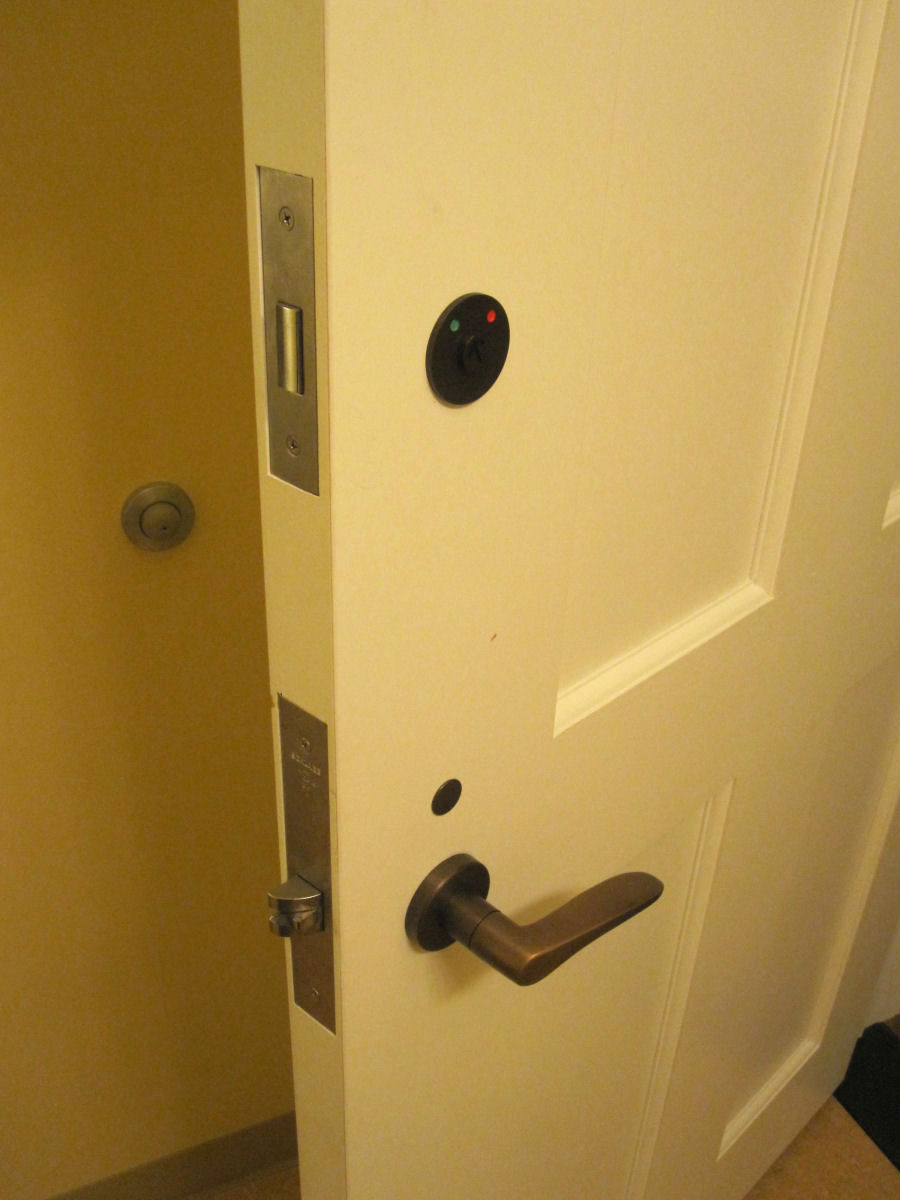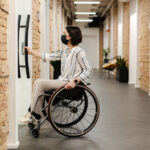This post was published in Doors and Hardware
 It’s hard to believe that this question still comes up as often as it does, so I’m hoping to definitively answer it once and for all. The question is “Do single bathrooms require locks which release with one operation?”
It’s hard to believe that this question still comes up as often as it does, so I’m hoping to definitively answer it once and for all. The question is “Do single bathrooms require locks which release with one operation?”
The question is most often asked in regard to single bathrooms, but it could apply to other rooms as well. Does a storage room door need to unlatch with one operation? How about a fitting room in a clothing store? I know it’s not uncommon to see a latchset/lockset with a separate deadbolt above it, but the locations where this is allowed are actually very limited.
Doors in a required means of egress must unlatch with one operation unless they’re on the list of exceptions below. When I say “unlatch with one operation,” I mean that when you turn the lever on a lockset, retract a deadbolt with a thumbturn, OR push on the touchpad of a panic device – only ONE of those operations, not multiple – the door is unlatched and ready to be opened. The act of opening the door by pushing or pulling on it does not count as one of the operations, as the requirement is that the doors UNLATCH with one operation, not OPEN with one operation.
I combed through the codes and standards to see what I could find on this topic, and here’s what I learned:
International Building Code states that “the unlatching of any door or leaf shall not require more than one operation.” The exceptions are 1) places of detention or restraint, 2) doors where manual flush bolts are allowed (more on that here), 3) doors with automatic flush bolts, and 4) doors from individual Group R dwelling units with an occupant load of 10 or less – a separate nightlatch, deadbolt, or security chain is allowed, as long as it doesn’t require a key or tool to release it from the interior.*
NFPA 101 states that the releasing mechanism on the door must not require more than one releasing operation, with the exception of residential dwelling units. The requirements for residential dwelling units are similar to the IBC – the separate lock on a dwelling unit door must be able to be released without a key or tool.* NFPA 101 does include an exception for existing hardware on rooms with an occupant load of 3 people or less, but technically the hardware would have to pre-date adoption of the requirement for one releasing operation; NFPA 101 has required one releasing operation since the 1988 edition. In the 2018 edition of NFPA 101, a change was made to allow a second releasing operation for existing classroom doors in K-12 schools, if certain criteria are met.
ADA & ICC/ANSI A117.1 – I could not find any language in the current standards regarding a single operation, only that the hardware is operable with one hand, but your local accessibility standards may include this requirement (Massachusetts AAB standards do).
NFPA 80 states that separate deadbolts are only allowed on fire doors which are not in the means of egress, which muddies things a bit because the life safety and building codes would allow a separate deadbolt on a fire-rated dwelling unit entry door. The life safety and building codes would prevail in this situation.
*Be careful of local codes as they may include requirements for accessible/adaptable dwelling units with interconnected locks.
The bottom line is that a single bathroom does require hardware which unlatches with one operation, and this would also apply to other types of rooms unless they are on the list of exceptions.
You need to login or register to bookmark/favorite this content.







What happens at a School toilet door that they want a deadbolt put on with a key operation inside the room so that the janitor can go in the toilet and lock it for cleaning. The two handed operation would only be required by the janitors action and he would be in the room? The door would look like the one in your blog but would only require one operation except by the janitor.
Hi Charlie –
There are VERY limited locations where you can have a key-operated deadbolt. I’ll do a post on that within the next few days. I don’t think many code officials would allow a double-cylinder deadbolt on a school bathroom. I know that in theory only the janitor would have the key, but the intent of the codes is to allow for free egress at all times.
– Lori
Hi Lori,
If I remember it was not a double cylinder deadbolt. The cylinder was inside and nothing on the outside. Similar to the Schlage L464.
Keep up the good work.
Charlie
EXIT = one action & no special knowledge.
This must be a multi use restroom?
If the door is prepped for a Cylindrical Lock (161) then remove the Passage Function and install a
Schlage ND70 SPA Classroom Lever lock.
Outside lever locked and unlocked by key only.
The key is the only way to lock (SECURED) or unlock (PASSAGE)
Inside lever is always unlocked for free immediate egress.
If you ever use a DEADBOLT on a closet/storage door at a K-12 School you should be using a
B563 Classroom deadbolt.
Deadbolt thrown or retracted by outside key only.
Inside Thumb Turn retracts the bolt only (unlock).
Inside Thumb Turn will not throw the bolt (lock).
Does the Group R Dwelling Unit exception include the apartment entry door in an apartment building or does it just refer to private homes? I’m working on a renovation job in Massachusetts where they want a separate dead lock on the fire rated unit entries.
Hi Bob –
An apartment would typically be a Group R dwelling unit. Since this project is in Massachusetts you need to go by MA 521CMR. I will send you a handout that talks about the Massachusetts requirements. If the units are “accessible” or “adaptable,” they need interconnected locks.
– Lori
I surveyed a hospital yesterday for Joint Commission violations and was told that they need to remove a mortise deadbolt (classroom function) from a closet in the corridor because there was a passage set below it. They said there cannot be more than 1 motion to get out.
I think it was unusual that they didn’t put a storeroom function lock in the first place.
Nolan: I see similar problems in hospitals with Behavioral Health units. Staff want to lock the doors to patient rooms when the rooms are vacant to keep wandering patients out of the rooms. They frequently will install dead-bolt locks above the latchset which are keyed from the corridor side, but in their own wisdom they will not install the thumb-turn on the inside of the room to retract the dead-bolt. When asked why they do this, they claim they do not want the patient holding the thumb-turn inside preventing staff from unlocking the door from the corridor side. (They are not aware there are locks available where the thumb-turn will not prevent the dead-bolt from being unlocked from the corridor side.) Also, this arrangement requires two actions to unlatch the door which is not permitted by the Life Safety Code, which Lori pointed out. In general, I find there is a large amount of ignorance on this issue in hospitals and with surveyors who inspect hospitals.
Hello
My name is Ken Diener and we are door and hardware distributor in chicago. Do you know if there is chicago code requiring Interconnected locks on any apartment or condo door?
thank you
Hi Ken –
I checked with GR Zechman in our Chicago office and he checked the Municipal Code of Chicago and did not find a requirement for interconnected locks on residential dwelling units. Chicago’s code includes the following section:
Chapter 13-164 – SECURITY DEVICES IN RESIDENTIAL BUILDINGS
This chapter applies to and regulates all one-family dwellings as defined in Section 13-56-030, all multiple dwellings, and all buildings of mixed occupancy having any dwelling units; provided, however, that the following shall be excluded from the requirements of this chapter:
(a) Owner-occupied dwelling units;
Every dwelling unit entrance door other than a sliding glass patio door shall be equipped with a deadbolt lock with at least a one-inch saw-resistant bolt projection, or with a rim-mounted deadbolt lock or vertical drop deadbolt lock providing equivalent security. Every such lock shall be operated from the outside by a key and from the inside by a turnpiece, handle or knob which does not require a key or any special knowledge to operate.
I hope this helps.
– Lori
With that said, the AHJ makes the final determination so you may want to contact the building official.
– Lori
I don’t get it? There are a lot of indicator deadbolts being sold for use on restroom doors: The Schlage B571, Arrow E50, Stanley K2 QDB 200, Falcon D271. If I understand this correctly, the only place you can use these indicator deadbolts is on a single use restroom with push/pulls. I am guessing all of these manufacturers must disagree with this. That sure is a lot of product being sold for such a narrow usage.
The statement “the unlatching of any door or leaf shall not require more than one operation” is from the IBC chapter on Means of Egress. I am sure we could argue that every door, in a building, except for small closets, is in the path of egress. However, even the code books use the statement “doors not in the path of egress,” so obviously not every door is in the path of egress. It seems like everyone spouts off the “one operation” statement anytime they want to justify why a deadbolt can’t be used. Like the doors on private offices, single use restroom doors are not usually in the path of egress and are allowed to have more than one operation to gain exit. This is why single use restroom doors can have a passage set and a separate indicator deadbolt.
In the end though, like Lori said, the AHJ makes the final decision about these matters regardless of how we choose to interpret the code books.
Schlage L9040 mortise lock
with Schlage
Inside trim L283-711, L283-712, L283-713, L283-714
Outside trim L283-721, L283-722, L283-723, L283-724
This setup is the only way to keep the local authority having jurisdiction happy
Not cheap…